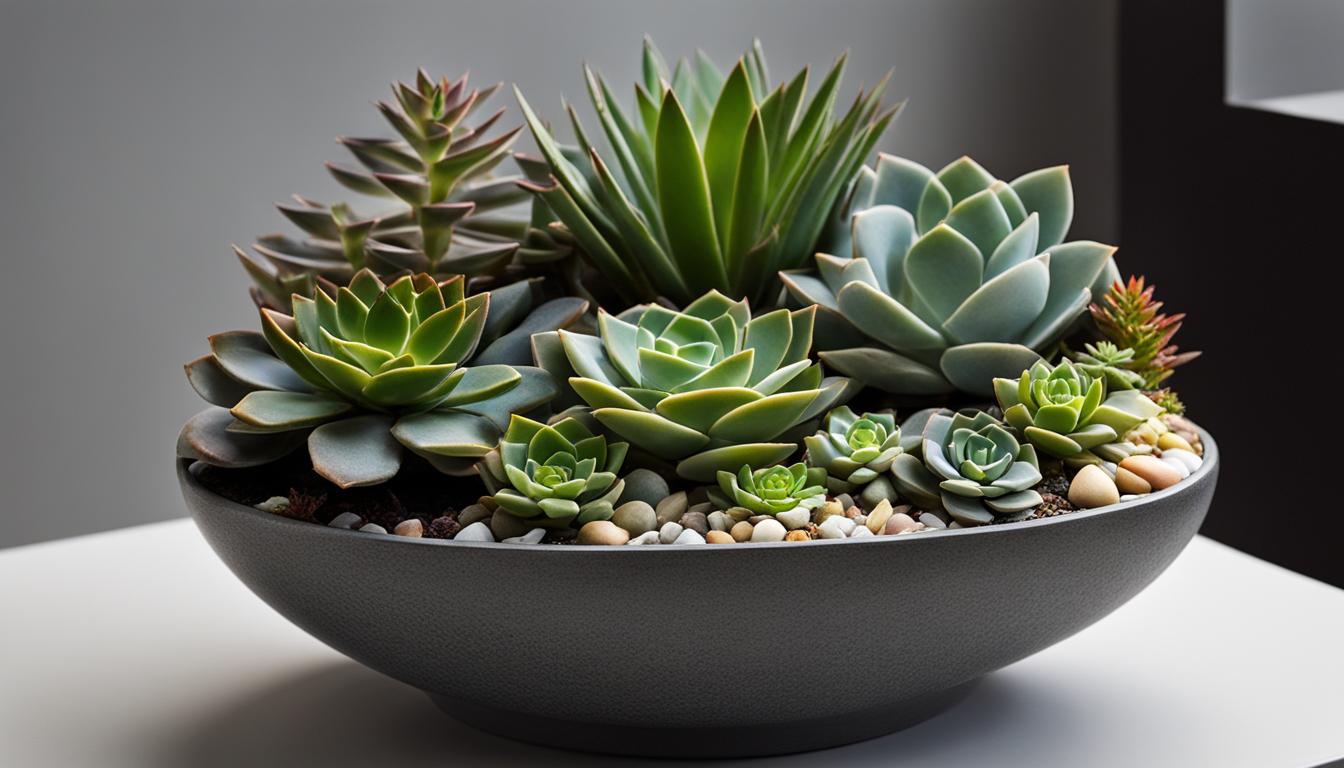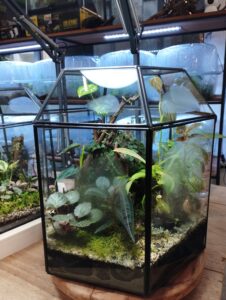Succulents are not just ordinary plants; they are a mesmerizing combination of beauty and resilience. These unique plants have captivated gardeners around the world with their stunning colors, intriguing shapes, and ability to thrive in all climates. If you want to elevate your plant game and create beautiful arrangements that will catch everyone’s eye, it’s time to master the art of succulent container design.
In this article, I will share valuable tips and inspiration that will help you craft striking succulent container gardens that you can proudly showcase in your indoor or outdoor space. Whether you’re a seasoned gardener or a beginner, you’ll find practical advice and creative ideas to make your succulent container designs truly stand out.
Key Takeaways:
- Learn the art of succulent container design to create stunning arrangements.
- Discover the beauty and resilience of succulents in both indoor and outdoor gardens.
- Choose the right containers that provide proper drainage and room for root growth.
- Maintain succulent container gardens with proper care, watering, and sunlight.
- Explore different succulent varieties and their compatibility for beautiful designs.
- Get inspired by the global succulent community and incorporate their ideas into your designs.
- Experience the therapeutic benefits of succulent gardening for mental well-being.
The Beauty of Succulent Container Gardens
Succulent container gardens offer a unique and stunning way to showcase these beautiful plants. With their vibrant colors, diverse shapes, and various sizes, succulents are perfect for creating eye-catching arrangements that will elevate the aesthetic of any space. Whether you’re looking to brighten up your indoor living areas with an indoor succulent garden or add a touch of greenery to your outdoor patio with an outdoor succulent garden, the options for succulent container design are limitless.
One of the advantages of succulent container gardening is the versatility it offers. Indoor succulent gardens bring the beauty of nature indoors and are a popular choice for adding a touch of greenery to living rooms, kitchens, or office spaces. These miniature gardens can be easily personalized to match your interior design style, creating a soothing and inviting atmosphere.
Outdoor succulent gardens, on the other hand, allow you to take advantage of the natural beauty of succulents while enhancing your outdoor living spaces. Whether you have a small balcony or a spacious backyard, succulent container gardens are a great way to add texture, color, and visual interest to your outdoor areas. From creating focal points to bordering pathways or adorning your patio table, the possibilities for designing outdoor succulent gardens are as endless as your imagination.
Whether you opt for an indoor or outdoor succulent garden, one of the key advantages of container gardening is the ability to easily move and rearrange your plants. This flexibility allows you to experiment with different layouts and designs, ensuring that your succulent container garden always reflects your evolving taste and style.
“Succulent container gardens are a beautiful and versatile way to bring the natural beauty of succulents into your home or outdoor living areas.”
Finding Inspiration for Succulent Container Gardens
When it comes to succulent container gardens, inspiration can be found everywhere. From online platforms and social media communities dedicated to succulent gardening to local nurseries and botanical gardens, there are countless sources of inspiration for designing your own succulent container gardens.
- Explore online platforms such as Pinterest and Instagram, where you’ll find a wealth of ideas and inspiration for succulent container designs.
- Visit local nurseries and garden centers, where you can see the different varieties of succulents and get expert advice from knowledgeable staff.
- Take a trip to your nearest botanical garden or succulent show to see stunning displays of succulent container gardens and gain insight into different design techniques.
Remember, the key to creating beautiful succulent container gardens is to let your creativity guide you. Experiment with different combinations of succulents, container types, and decorative elements to create unique and visually appealing arrangements that reflect your personal style.
Benefits of Succulent Container Gardens
Succulent gardening offers numerous benefits beyond their aesthetics. Here are a few reasons why succulent container gardens are a great choice:
- Succulents are low-maintenance plants that require minimal watering and care, making them ideal for busy individuals or those new to gardening.
- Indoor succulent gardens can improve indoor air quality by filtering toxins and releasing oxygen.
- The presence of plants, such as succulents, has been shown to improve mood, reduce stress, and increase productivity.
- Container gardens can be easily adapted to suit any living space, regardless of size or location.
Creating a Striking Succulent Container Garden
Designing a succulent container garden is a creative process that allows you to express your personal style and preferences. Here are some key considerations to keep in mind:
- Choose a focal point for your container garden, such as a larger or more colorful succulent, and build around it.
- Consider the color, shape, and texture of the succulents you choose to create contrast and visual interest.
- Ensure that the containers you select have proper drainage to prevent overwatering.
- Experiment with different levels and heights by using rocks, pebbles, or decorative items to add dimension to your container garden.
| Succulent Variety | Light Requirements | Watering Frequency | Growth Habit |
|---|---|---|---|
| Echeveria | Full sun to partial shade | Water when soil is dry | Rosette-shaped |
| Sedum | Full sun to partial shade | Water sparingly | Upright and trailing |
| Aloe | Bright indirect light to full sun | Water every 2-3 weeks | Upright and branching |
By considering these factors and allowing your creativity to flow, you can create a striking succulent container garden that adds beauty and tranquility to your space.
Choosing the Right Succulent Containers
When it comes to succulent container design, selecting the right containers is a crucial step. Succulents have specific needs, particularly when it comes to drainage and airflow. Therefore, it’s essential to choose containers that provide adequate drainage and enough room for the roots to grow.
Succulent containers come in various options, ranging from traditional pots to unique and creative alternatives. Let’s explore some popular choices:
- Traditional pots: These are the most common and versatile option for succulent containers. They come in different sizes, materials, and designs to suit your taste and gardening style. Ensure that the pots have drainage holes to prevent water accumulation, which can cause root rot.
- Self-watering containers: These containers have a built-in watering system that allows for proper moisture control. They feature a reservoir at the bottom, which supplies water to the plants as needed. This is an excellent option for those who tend to underwater or overwater their succulents.
- Hanging baskets: Hanging baskets not only provide a unique way to display your succulents but also allow for better airflow. They are ideal for cascading succulent varieties that gracefully spill over the edges.
- Teacups and other unconventional containers: Get creative and repurpose unique items like teacups, mugs, glass terrariums, or even old shoes as succulent containers. These unconventional choices add a touch of personality and whimsy to your succulent arrangements.
Remember, regardless of the container you choose, make sure it offers proper drainage. Succulents thrive in well-draining soil, and excess moisture can lead to root rot. Additionally, give your succulents enough room to grow and spread their roots.
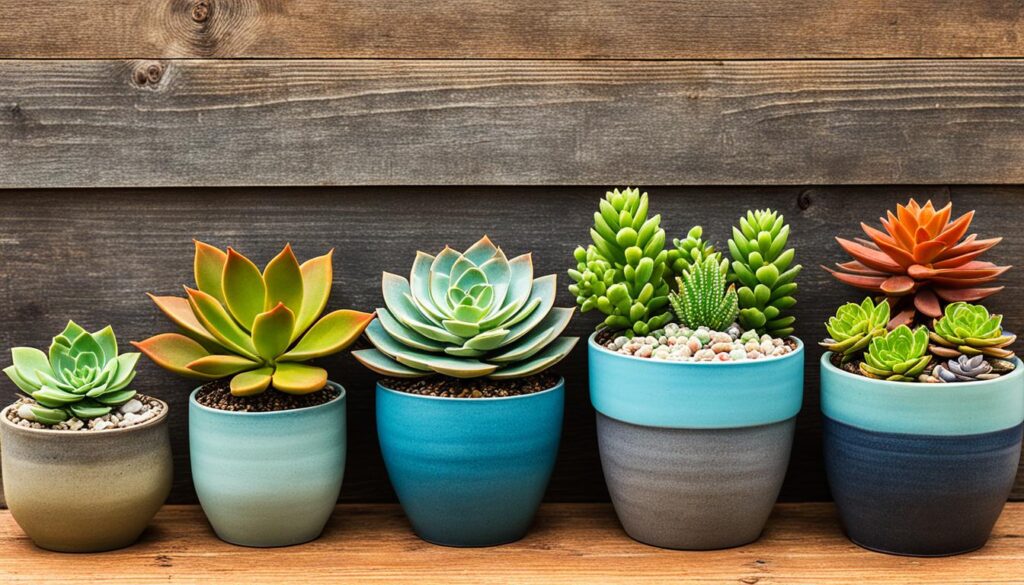
Now that you know the importance of choosing the right succulent containers, let’s move on to the next section where we’ll learn about caring for succulent container gardens.
Caring for Succulent Container Gardens
When it comes to caring for succulent container gardens, it’s important to understand the unique needs of these resilient plants. Succulents are known for their ability to thrive in harsh conditions, making them a popular choice for low-maintenance gardens. However, they still require some attention to ensure their health and longevity.
Proper Watering Techniques
One of the most important aspects of caring for succulent container gardens is proper watering. Succulents are drought-tolerant plants, meaning they have adapted to survive in dry environments with minimal water. Overwatering can be detrimental to their health, causing root rot and other issues.
To avoid overwatering, it’s crucial to allow the soil to dry out completely before watering again. This means waiting until the top inch of soil is dry to the touch. You can use your finger or a moisture meter to check the moisture level of the soil.
When watering your succulent container garden, be sure to water thoroughly but avoid leaving standing water in the container. Water should be able to drain freely from the drainage holes, preventing root rot. It’s also important to use a well-draining soil mix specifically formulated for succulents.
Adequate Sunlight Exposure
Succulents thrive in bright light conditions and require ample sunlight to grow and maintain their unique forms. When caring for your succulent container garden, be sure to place it in a location that receives at least six hours of direct sunlight per day.
If you’re growing succulents indoors, consider placing them near a south-facing window or using supplemental grow lights to provide adequate light. Without enough sunlight, succulents may become stretched or pale in color, indicating a lack of light exposure.
Occasional Fertilization
While succulents are generally low-maintenance plants, they can benefit from occasional fertilization to promote healthy growth and vibrant colors. However, it’s important not to over-fertilize, as this can lead to excessive foliage growth and reduced plant resilience.
When fertilizing your succulent container garden, use a balanced fertilizer specifically formulated for succulents. Follow the instructions on the fertilizer package, applying at the recommended frequency and dosage. During the active growing season, which is typically spring and summer, you can fertilize once a month. However, during the dormant season, reduce or eliminate fertilization.
| Watering | Sunlight | Fertilization |
|---|---|---|
| Water thoroughly when soil is dry Avoid overwatering and standing water | Place in a location with at least 6 hours of direct sunlight per day Use grow lights for indoor gardens | Fertilize with a balanced succulent fertilizer once a month during the active growing season Reduce or eliminate fertilization during the dormant season |
By following these care guidelines for your succulent container garden, you can ensure that your plants thrive and remain healthy. Remember, succulents are resilient, but they still rely on your care and attention to flourish.
Next, we’ll dive into the exciting world of succulent container garden design, exploring different arrangements and plant combinations to create stunning displays. Stay tuned!
Designing a Succulent Container Garden
Designing a succulent container garden is an exciting and creative process that allows you to showcase your personal style and create a stunning centerpiece for your home or garden. When designing your succulent container garden, there are a few key factors to consider to ensure a visually appealing and thriving display.
Choosing the Right Succulents
When selecting succulents for your container garden, consider the colors, shapes, and textures that will complement each other and create a harmonious arrangement. This will enhance the overall aesthetic appeal of your design. Here are some of the best succulents for containers:
- Echeveria: Known for their rosette-shaped leaves and vibrant colors, Echeveria varieties, such as ‘Lola’ or ‘Black Prince’, are popular choices for container gardens.
- Sedum: Sedums, like Sedum acre or Sedum dasyphyllum, are versatile succulents that come in a variety of forms and colors, making them great additions to any container arrangement.
- Aloe: With their spiky leaves and striking flowers, aloes, such as Aloe vera or Aloe aristata, add architectural interest to container gardens.
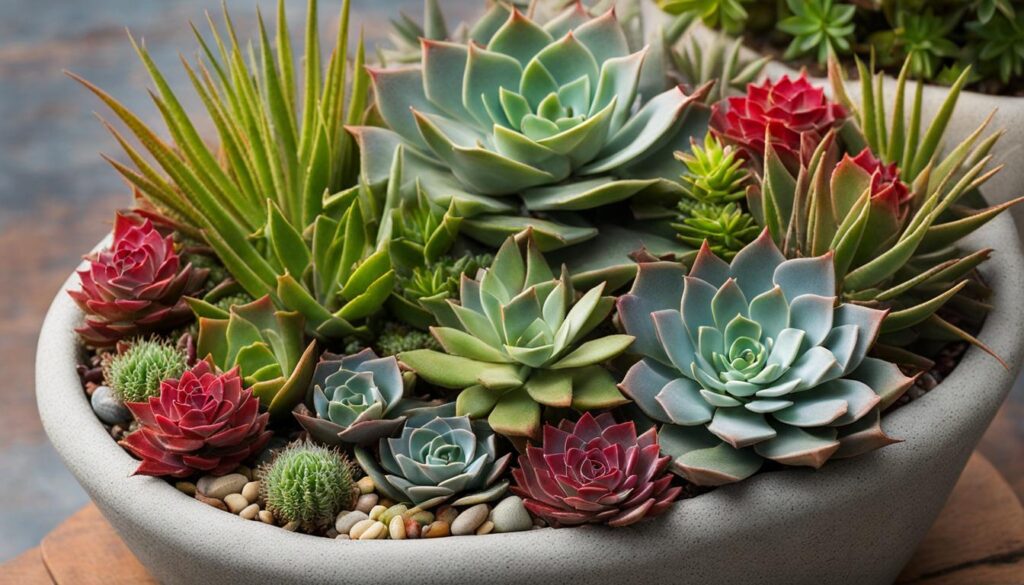
Container Size and Placement
Consider the size of your container when designing your succulent garden. Too small of a container may restrict root growth and overcrowd the succulents, while too large of a container may leave gaps and lack visual impact. Choose a container that provides enough space for the succulents to grow and thrive.
When it comes to placement, think about where your succulent container garden will be displayed. Whether it’s indoors on a windowsill or outdoors on a patio, consider the lighting conditions and choose succulents that will thrive in that specific environment.
Creating Visual Interest
To create visual interest in your succulent container garden, vary the heights, colors, and textures of your succulents. Combine tall, upright succulents with trailing or cascading varieties for a dynamic arrangement. Play with different combinations to find a balance that pleases your eye.
“The key to a captivating succulent container garden is thoughtful design and arrangement. By considering the colors, sizes, and shapes of your succulents, you can create a visually stunning display that will be the envy of all who see it.”
With careful consideration of succulent selection, container size, and thoughtful arrangement, you can design a succulent container garden that is visually captivating and brings joy to your space. Experiment, have fun, and let your creativity shine!
Propagating Succulents for Container Gardens
Propagating succulents is an exciting and cost-effective way to expand your succulent collection and create beautiful container gardens. With a little knowledge and some simple techniques, you can easily grow new succulent plants from existing ones.
Succulents can be propagated through stem cuttings, leaf cuttings, or by separating offsets from the mother plant. Let’s take a closer look at each method:
1. Stem Cuttings
Stem cuttings involve taking a piece of stem from an established succulent and allowing it to root and grow into a new plant. Here are the steps:
- Select a healthy, mature stem from the parent plant.
- Using a sharp and clean knife or shears, make a clean cut below a leaf node.
- Allow the cutting to dry and callous for a few days to prevent rot.
- Once calloused, place the cutting in a well-draining potting mix, burying the bottom third of the stem.
- Keep the soil lightly moist, but not overly wet.
- After a few weeks, roots should start to develop, and a new plant will begin to grow.
2. Leaf Cuttings
Leaf cuttings involve removing a healthy leaf from a succulent to grow a new plant. Follow these steps:
- Choose a plump, healthy leaf from the parent plant.
- Gently twist the leaf from the stem, ensuring that the entire leaf is intact.
- Allow the leaf cutting to dry and callous for a few days.
- Place the leaf cutting on top of a well-draining potting mix, or partially bury the leaf if it’s large.
- Mist the soil lightly to keep it moist, but avoid overwatering.
- Over time, roots will sprout from the base of the leaf, and a new plant will emerge.
3. Separating Offsets
Many succulents produce offsets, also known as “pups,” which are small plants that grow alongside the main plant. Separating and replanting these offsets is another way to propagate succulents. Here’s what to do:
- Gently remove the offset from the parent plant once it has grown a few leaves.
- Allow the offset to dry and callous for a day or two.
- Plant the offset in a well-draining potting mix, burying the base of the plant.
- Water the newly planted offset lightly and avoid overwatering.
- In due course, the offset will establish roots and start growing as a separate succulent.
Remember, each succulent species may have unique propagating requirements, so it’s essential to research the specific needs of the succulents you are propagating. With patience and care, you can easily propagate succulents and create an abundance of new plants for your container gardens.
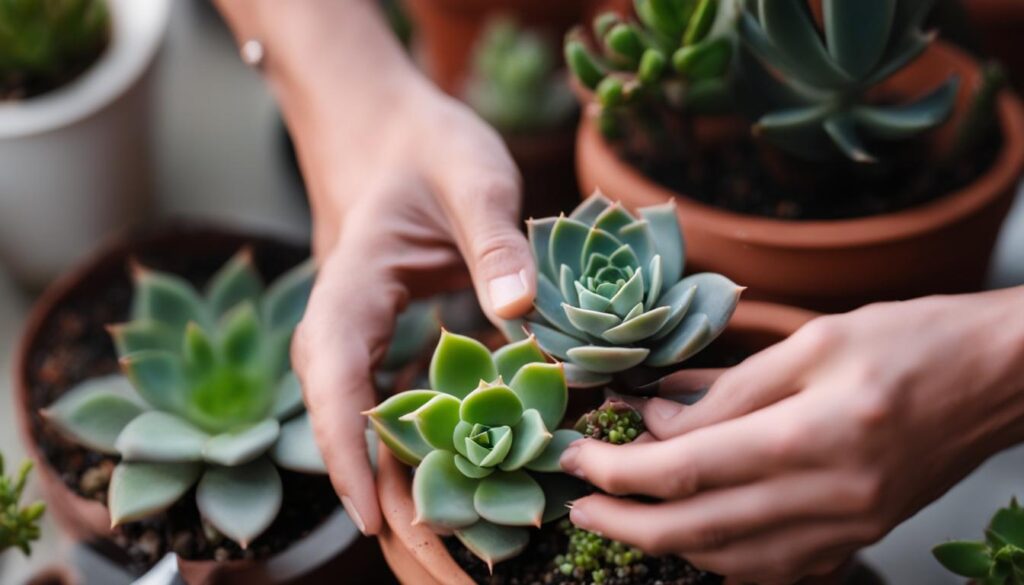
Overwintering Succulent Container Gardens
Overwintering succulent container gardens can be a challenge, especially if you live in a cold climate. Succulents are typically frost-sensitive and can be damaged or killed by freezing temperatures. To protect your succulents during the winter months, it’s important to bring them indoors or provide them with adequate protection.
One option for overwintering succulent container gardens is to bring them indoors. Find a bright and sunny location for your succulents, such as a south-facing window or a well-lit room. Keep in mind that succulents still need some exposure to cold temperatures to ensure healthy growth, so avoid keeping them in excessively warm areas.
If you don’t have enough space indoors or want to keep your succulents outdoors, consider using frost blankets to provide protection from freezing temperatures. Frost blankets are lightweight and breathable, allowing air and moisture to pass through while protecting your plants from frost damage. Be sure to secure the frost blanket tightly around the container to prevent any drafts.
Another option is to move your succulent container gardens to a sheltered location, such as a covered patio or a greenhouse. This can provide the necessary protection from cold winds and freezing temperatures while still allowing your succulents to receive adequate light. Just make sure the sheltered area still allows for proper airflow and avoids excessive moisture buildup.
When overwintering your succulent container gardens, it’s important to adjust your watering schedule. Succulents go through a dormant period during the winter months, so they require less water. Only water your succulents when the soil is completely dry, and be mindful not to overwater as this can lead to root rot. Remember, it’s better to underwater than to overwater during this time.
By taking the necessary steps to overwinter your succulent container gardens, you can ensure the survival and health of your plants through the colder months. With the right care and protection, your succulents will be ready to thrive and flourish when spring arrives.
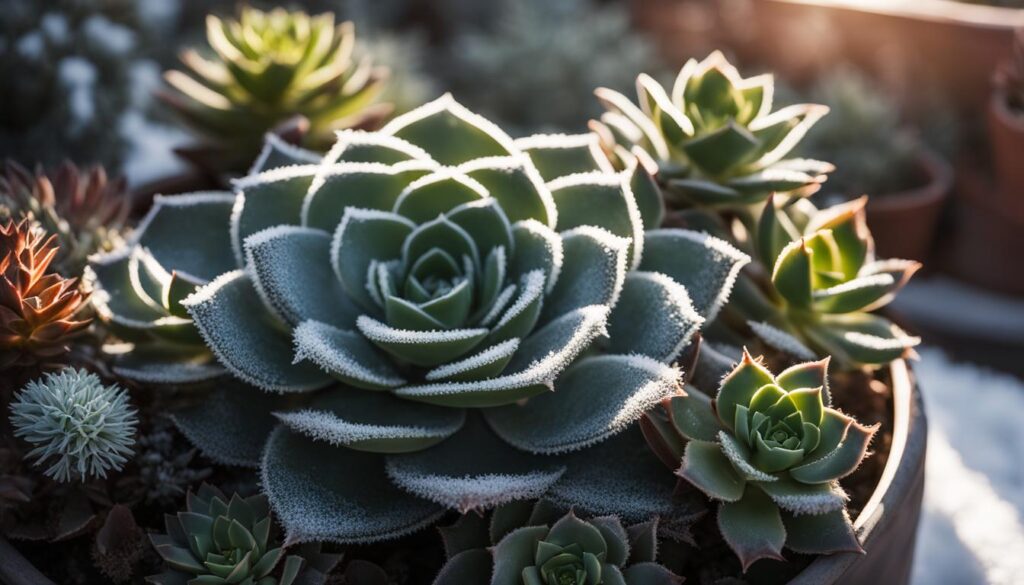
Troubleshooting Common Succulent Container Garden Issues
While succulent container gardens are generally low-maintenance, it’s important to be aware of common issues that can arise. By knowing how to identify and address these problems, you can ensure the health and vitality of your succulent garden.
Pests:
Pests, such as mealybugs and aphids, can infest your succulent plants and cause damage if not addressed promptly. Regularly inspect your plants for any signs of pests, such as tiny insects or sticky residues on the leaves. If you notice any pests, try using natural remedies like neem oil or insecticidal soap to control the infestation. Alternatively, you can manually remove the pests by gently wiping them off with a cotton swab soaked in rubbing alcohol.
Diseases:
Succulents can be susceptible to diseases like fungal infections, root rot, and powdery mildew. To prevent these issues, provide proper airflow and avoid overwatering your plants. If you notice any signs of disease, such as discolored or mushy leaves, take prompt action to address the problem. Remove infected leaves or plants to prevent the spread of the disease, and consider using a fungicide if necessary.
Regularly inspect your succulent container garden for signs of pests or disease, such as mealybugs or rot. If you notice any issues, take prompt action to address the problem and prevent further damage.
Overwatering:
Overwatering is one of the most common mistakes made in succulent container gardening. Succulents are adapted to survive in arid conditions and prefer well-draining soil. To avoid overwatering, allow the soil to dry out completely between waterings. When you do water your succulents, make sure to thoroughly saturate the soil and allow any excess water to drain out. If you notice signs of overwatering, such as yellowing leaves or root rot, adjust your watering schedule accordingly.
By being proactive in troubleshooting these common issues, you can ensure the health and beauty of your succulent container garden. Regular inspection and prompt action are key to maintaining thriving succulent plants.
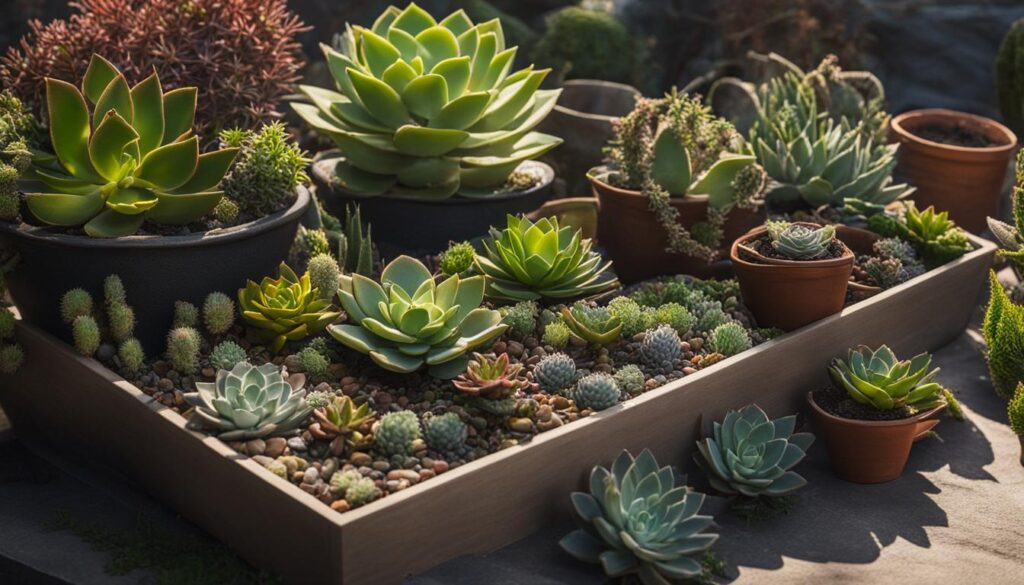
Now that you’re equipped with the knowledge to troubleshoot common succulent container garden problems, you can confidently care for your plants and enjoy the beauty they bring to your space.
Creating Miniature Succulent Container Gardens
If you’re looking to add a touch of whimsy and charm to your succulent collection, miniature succulent container gardens are the perfect choice. These tiny gardens, crafted in small containers such as teacups or tiny terrariums, offer a unique and enchanting display that is sure to captivate. Whether you want to add a decorative accent to a small space or create a conversation piece for your living room, miniature succulent gardens are a delightful addition to any indoor or outdoor setting.
“Miniature succulent container gardens are an opportunity to create a small world that tells a story, evokes emotion, and sparks joy.”
Creating a miniature succulent garden is a creative endeavor that requires careful selection of small succulents and the right accessories to bring your tiny world to life. Here are a few tips to get you started:
1. Choose the Right Small Succulent Containers
When creating a miniature succulent garden, the choice of container is crucial. Opt for small containers that complement the scale of the succulents and allow for a harmonious arrangement. Teacups, tiny pots, or glass terrariums are great options for creating a cozy and inviting scene.
2. Select Small Succulents
As these miniature gardens have limited space, it’s important to choose small succulents that will fit comfortably and thrive in the container. Look for varieties that stay compact and have interesting shapes, textures, and colors. Some suitable choices include Crassula tetragona, Haworthia cooperi, and Sedum rubrotinctum.
3. Add Miniature Accessories
To create a realistic and captivating scene, incorporate miniature accessories into your succulent container garden. Tiny figurines, fairy houses, small rocks, or even miniature furniture can add a whimsical touch and enhance the overall aesthetic.
With these essentials in mind, let your creativity run wild as you design and assemble your miniature succulent container garden. Experiment with different combinations, textures, and themes to create a truly unique and personalized display.
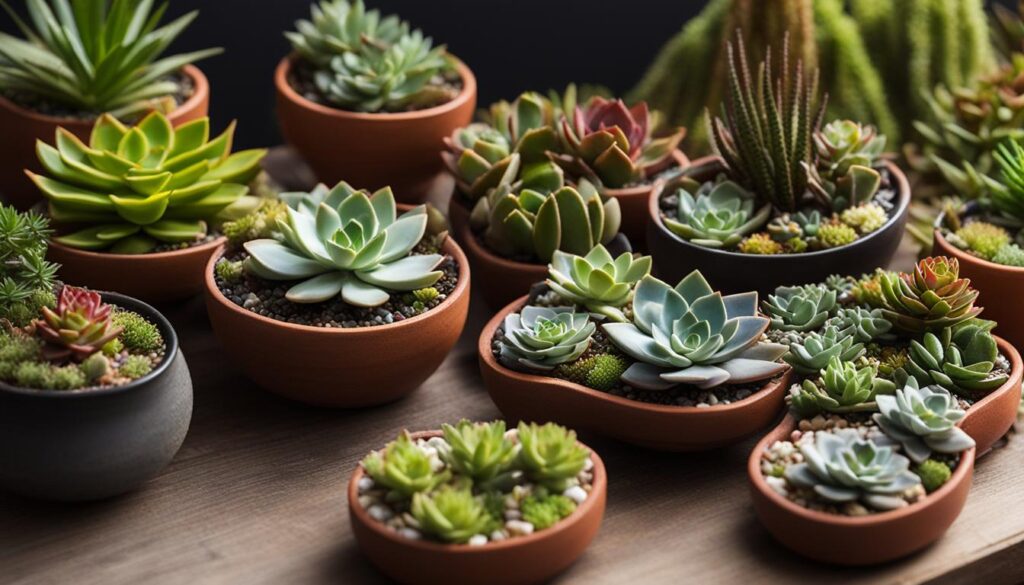
| Advantages of Miniature Succulent Container Gardens | Considerations |
|---|---|
| Perfect for small spaces | Requires regular maintenance |
| Adds a decorative accent | May need occasional repotting |
| Provides a unique and charming display | Requires careful selection of small succulents |
| Offers a creative and artistic outlet | May require specialized containers |
Exploring the Global Succulent Community
The global succulent community is a thriving and diverse network of succulent enthusiasts and collectors from around the world. It’s a place where we can connect, share our love for these beautiful plants, and learn from each other’s experiences.
In today’s digital age, online forums and social media groups have become invaluable resources for succulent lovers. These platforms provide a space for us to ask questions, seek advice, and showcase our prized succulents. It’s a virtual succulent community where we can share our successes, troubleshoot common issues, and even participate in online succulent swaps.
“I love being part of the global succulent community! The knowledge and passion that fellow succulent enthusiasts bring to the table is inspiring. It’s amazing to connect with people from different parts of the world who share the same love for these fascinating plants.”
Additionally, local succulent clubs and societies offer an opportunity for succulent collectors to connect on a more personal level. These organizations often host meetings, workshops, and plant sales where members can gather, exchange tips, and expand their succulent collections. It’s a chance to meet like-minded individuals who understand our obsession with succulents!
Not only do succulent enthusiasts connect online and through local clubs, but many of us also embark on succulent-themed adventures. We travel to exotic locations to explore succulent hotspots, such as the arid deserts of Southern California or the breathtaking landscapes of South Africa. These journeys not only allow us to admire succulent diversity in their natural habitats but also provide inspiration for our own container designs and gardening techniques.
The global succulent community is a supportive and inclusive space that embraces succulent collectors of all experience levels. Whether you’re a seasoned collector or just starting, you can find camaraderie, knowledge, and endless succulent inspiration among this vibrant community.
Benefits of the Global Succulent Community
| Benefits | Description |
|---|---|
| Knowledge Sharing | Exchange tips, advice, and information on succulent care, propagation, and design. |
| Inspiration | Discover new succulent varieties, container designs, and gardening techniques from across the globe. |
| Support | Connect with like-minded individuals who can offer guidance and encouragement on your succulent journey. |
| Succulent Swaps | Participate in online or local plant exchanges to expand your succulent collection. |
| Travel Adventures | Embark on succulent-themed trips to explore succulent hotspots and gain firsthand inspiration. |
Join the global succulent community today and immerse yourself in a world of succulent beauty, knowledge sharing, and lifelong friendships. Together, we can continue to celebrate and nurture the incredible diversity of succulents while fostering a sense of belonging and connection.
The Therapeutic Benefits of Succulent Gardening
Succulent gardening is more than just a hobby – it can also be a therapeutic and fulfilling activity that nurtures both the mind and the soul. Engaging in succulent gardening provides a sense of calm and tranquility, allowing individuals to disconnect from the stresses of daily life and find solace in nature.
When I immerse myself in succulent gardening, I often feel a deep sense of peace wash over me. The act of tending to these resilient plants brings about a meditative state, where I can fully focus on the present moment and let go of any worries or anxieties. It’s as if the vibrant colors and unique forms of succulents have the power to transport me to a place of serenity.
Working with succulents also offers a wonderful sense of accomplishment and satisfaction. As I carefully nurture these plants, observing their growth and progress, I can’t help but feel a deep sense of pride and joy. Seeing a succulent thrive under my care reaffirms my connection to the natural world and reminds me of the beauty and resilience of life itself.
“Gardening is the purest of human pleasures.”
― Francis Bacon
Moreover, succulent gardening can have a profound impact on mental health. Research has shown that spending time in nature and engaging in gardening activities can reduce stress, anxiety, and depression. The repetitive actions of planting, watering, and tending to succulents can help clear the mind and promote a sense of inner calmness.
But the therapeutic benefits of succulent gardening don’t stop at the mental level – they extend to physical well-being as well. Spending time outdoors, breathing in fresh air, and getting our hands dirty can boost our immune system, improve sleep quality, and increase overall vitality.
The Healing Power of Nature
There’s something inherently healing about being surrounded by nature. The sights, sounds, and smells of a succulent garden can awaken our senses and bring us closer to the natural world. The gentle rustling of leaves, the vibrant colors, and the subtle fragrance of succulents all contribute to a soothing and rejuvenating experience.
Research has also shown that gardening activities can improve cognitive function and memory. From planning the layout of a succulent garden to learning about different species and their specific care needs, gardening stimulates the brain and keeps it sharp and active.
Ultimately, succulent gardening allows us to reconnect with our roots and tap into the primal joy of nurturing and cultivating life. It reminds us of our inherent connection to the Earth and the cycles of growth and renewal that characterize the natural world.
As you embark on your own succulent gardening journey, remember to approach it with an open heart and a mindful spirit. Take the time to observe, touch, and feel the textures of your succulents. Create a sanctuary for yourself in the midst of nature, where you can find solace, inspiration, and a deeper sense of self.
| Therapeutic Benefits of Succulent Gardening | |
|---|---|
| Promotes mindfulness and relaxation | ✓ |
| Improves mental health and well-being | ✓ |
| Boosts physical health and vitality | ✓ |
| Enhances cognitive function and memory | ✓ |
| Nurtures a sense of connection with nature | ✓ |
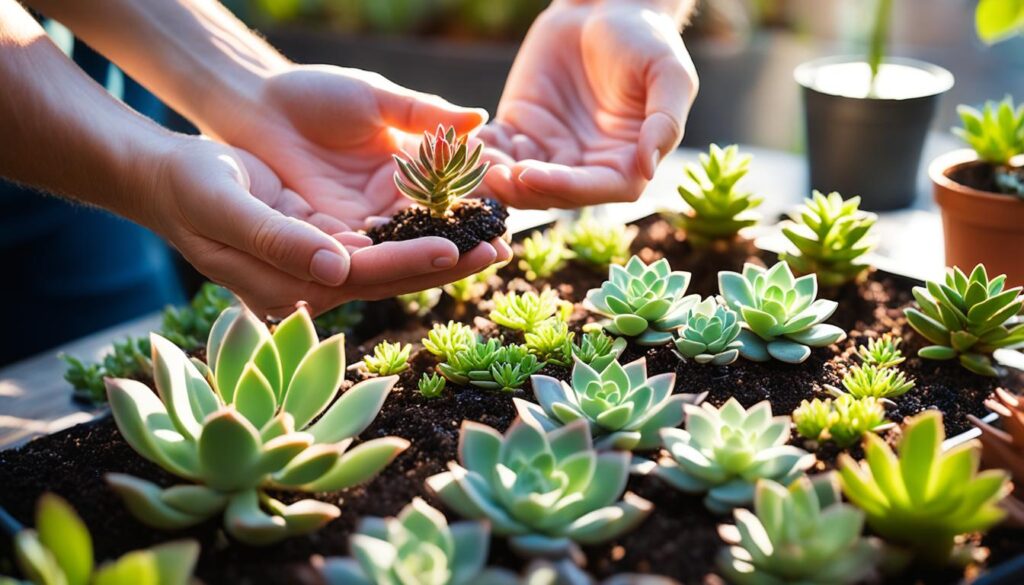
Sustainable Practices in Succulent Container Design
Sustainable practices are essential in today’s gardening world, and succulent container design is no exception. By adopting eco-friendly methods and considering the environmental impact of our choices, we can create beautiful succulent container gardens that are not only visually appealing but also sustainable.
One of the key aspects of sustainable succulent gardening is the use of eco-friendly materials. Opt for containers made from recycled materials or choose biodegradable options that can be composted at the end of their life cycle. This reduces waste and minimizes the impact on the environment.
Water conservation is another crucial aspect of sustainable gardening. Succulents are known for their ability to tolerate drought, so it’s important to avoid overwatering. By practicing responsible watering habits and using techniques like drip irrigation or self-watering containers, we can minimize water waste and preserve this precious resource.
Choosing native or drought-tolerant succulents is also a sustainable choice. Native plants are well-adapted to their natural environment and require less water and maintenance compared to non-native species. By selecting native or drought-tolerant succulents, we can reduce the need for excessive watering and the use of fertilizers or pesticides.
When designing a sustainable succulent container garden, consider incorporating other eco-friendly elements such as renewable energy-powered garden lighting or incorporating organic fertilizers and soil amendments. These small choices can have a positive impact on the environment and promote a more sustainable gardening approach.
By implementing sustainable practices in succulent container design, we not only contribute to the preservation of our planet but also ensure the long-term health and success of our succulent gardens. Let’s create beautiful, eco-friendly spaces where succulents can thrive while leaving a minimal ecological footprint.
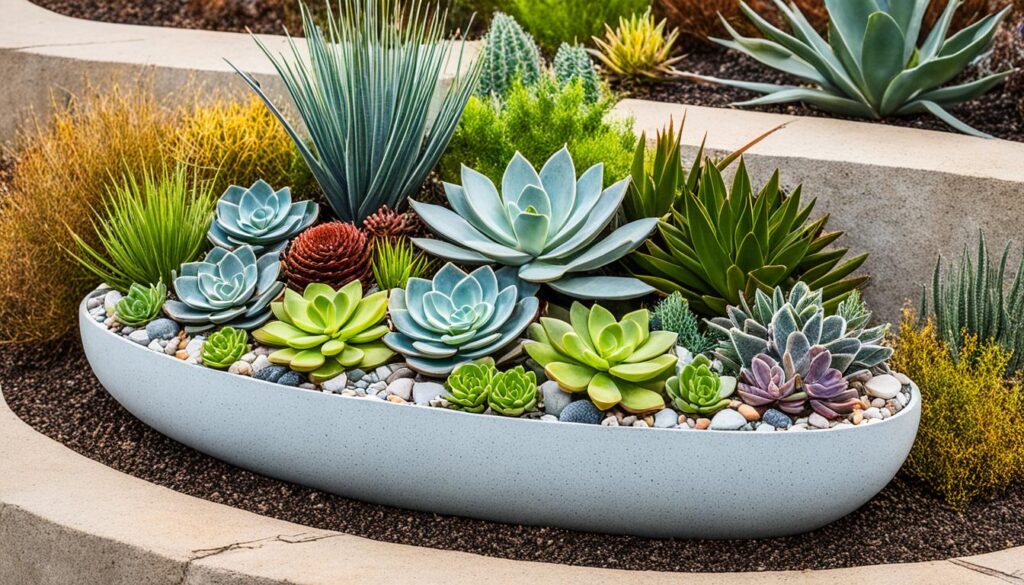
Key Sustainable Practices for Succulent Container Design:
- Use eco-friendly materials for containers, such as recycled or biodegradable options.
- Practice water conservation by avoiding overwatering and utilizing efficient irrigation systems.
- Choose native or drought-tolerant succulents to reduce water usage and maintenance.
- Incorporate renewable energy sources and organic fertilizers in your garden.
By following these sustainable practices, you can create a thriving and environmentally-friendly succulent container garden that brings joy and beauty to your space.
Crafting Your Personal Succulent Oasis
Crafting your own personal succulent oasis is a delightful way to create a space that reflects your unique style and preferences. Whether you envision an indoor succulent garden that brings life and beauty to your home or an outdoor succulent display that adds vibrance to your patio or garden, the possibilities are endless. With careful planning and design, you can transform any space into a stunning succulent oasis, where you can find joy and tranquility in the presence of these beautiful plants.
Indoor succulent gardens offer the perfect opportunity to bring nature indoors and create a soothing and inviting atmosphere. These compact and low-maintenance gardens can be placed on windowsills, shelves, or as centerpiece arrangements, adding a touch of greenery to any room. By selecting a variety of succulent species with different colors, shapes, and textures, you can create a visually intriguing and personalized indoor succulent garden that complements your interior decor.
On the other hand, outdoor succulent gardens provide a stunning display that can transform your outdoor living space into a lush and captivating oasis. Whether you have a small balcony, a spacious backyard, or a dedicated garden area, outdoor succulent gardens can thrive in a range of climates and environments. With a mix of succulents, ornamental rocks, and decorative elements, you can design an outdoor succulent garden that becomes a focal point and conversation starter among your guests.
“By incorporating succulents, you can add an exquisite touch to your garden or home, making it a personal sanctuary.” – Lisa Anderson, Succulent Enthusiast
Creating a personal succulent oasis involves more than just choosing the right plants. It’s also about selecting the perfect containers, considering the overall design and layout, and ensuring proper care and maintenance. Let your imagination run wild and experiment with various container materials and designs, such as ceramic pots, terracotta planters, or even repurposed objects like vintage crates or driftwood. The choice of containers can enhance the aesthetic appeal of your succulent oasis and bring your personal style to life.
Remember, succulents are hardy plants that are well-suited to various climates, making them an excellent choice for both indoor and outdoor gardens. Their ability to store water in their leaves allows them to thrive in drier conditions, making them low-maintenance and resilient. However, it’s important to provide them with the right amount of sunlight, well-draining soil, and occasional watering to ensure their health and vitality.
Premium Succulent Container Brands
| Brand | Description | Price Range |
|---|---|---|
| Succulent Artworks | Handcrafted ceramic containers with intricate designs | $20 – $50 |
| Modern Succulents | Minimalistic and contemporary containers made from sustainable materials | $15 – $30 |
| Nature’s Serenity | Natural and eco-friendly containers made from reclaimed wood | $25 – $50 |
Remember, the key to crafting your personal succulent oasis is to let your creativity shine. Experiment with different succulent combinations, container arrangements, and decorative elements to create a truly unique and inviting space. With a little imagination and a lot of love for succulents, you can transform any area into a breathtaking succulent oasis that brings you happiness and serenity.
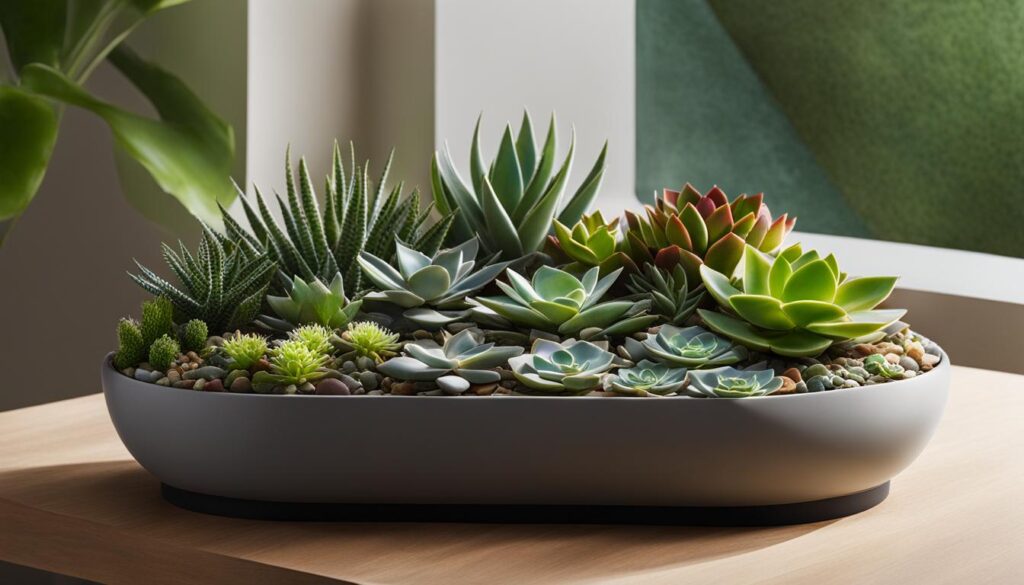
Embracing the Artistic Expression of Succulent Container Design
Succulent container design goes beyond mere gardening; it is a medium for artistic expression. Through the careful selection of succulents and arranging them in visually pleasing compositions, you can unleash your creativity and create breathtaking succulent container gardens. By integrating color, texture, and form, you have the power to craft truly striking and artistic succulent arrangements that not only showcase the beauty of these plants but also reflect your unique style and personality.
The process of designing succulent containers is akin to creating artwork. Just as a painter selects different hues to evoke specific emotions, succulent enthusiasts have the opportunity to curate a palette of succulents with varying shades and tones. Combining contrasting colors can create a dynamic visual impact, while harmonious color schemes can convey a sense of serenity and balance.
Texture is another essential element in succulent container design. The diverse range of textures among succulents, from smooth and velvety to spiky and jagged, adds depth and tactile interest to your arrangements. By carefully considering the surface textures of different succulent varieties, you can create captivating compositions that entice both the eye and the touch.
Form plays a crucial role in sculpting the overall aesthetic of your succulent container gardens. You have the freedom to experiment with succulents of various shapes and sizes, combining upright growers with trailing varieties to add depth and visual movement. Curvaceous rosettes, architectural columns, and cascading tendrils all contribute to the overall composition and artistic effect.
When creating artistic succulent arrangements, it’s important to consider the principles of design. Some key principles to keep in mind include balance, proportion, and focal points. By arranging succulents in a balanced and harmonious way, you can create a sense of equilibrium and visual stability. Proportionate placement of different succulent varieties ensures that no single plant overwhelms the composition. Finally, focal points draw attention and create a sense of intrigue and visual interest.
Just as an artist relies on their intuition and personal expression, succulent container design allows you to unleash your creativity and create living works of art that bring joy and beauty to your environment.
As you delve into the world of succulent container design, take inspiration from artists, nature, and your own imagination. Allow yourself the freedom to experiment with different combinations, textures, and forms. Push the boundaries of traditional design and explore unique and unconventional container choices. By embracing the artistic elements of succulent container design, you can create stunning arrangements that are not only visually striking but also reflect your personality and creativity.
Additional Resources:
- Books: “Succulent Container Gardens” by Debra Lee Baldwin, “The Art of Succulents” by Cassidy Tuttle
- Online Communities: Succulent and Cactus Society, Succulent Artists
- Workshops and Classes: Check local garden centers and botanical gardens for upcoming succulent design workshops.
| Succulent Container Design Tips | Artistic Succulent Arrangement Ideas |
|---|---|
| 1. Select succulents with contrasting colors to create vibrant compositions. | 1. Create a monochromatic arrangement using different succulent varieties of the same color. |
| 2. Combine succulents with varied textures for visual interest. | 2. Arrange succulents in a spiral pattern for a whimsical and dynamic look. |
| 3. Experiment with different container shapes and sizes to enhance the overall design. | 3. Create a focal point by placing a tall and striking succulent in the center of the arrangement. |
| 4. Group succulents of different heights to create depth and dimension. | 4. Incorporate trailing succulents to add movement and a cascading effect. |
| 5. Use natural elements like driftwood or stones to enhance the artistic appeal of your arrangement. | 5. Experiment with asymmetrical arrangements for a bold and contemporary look. |
Conclusion
Succulent container design is a fascinating and fulfilling endeavor that allows you to unleash your creativity and create stunning displays showcasing the natural beauty of these resilient plants. By carefully considering your choice of containers, providing proper care and maintenance, and embracing your artistic side, you can craft succulent container gardens that will undoubtedly captivate and inspire.
Whether you are a novice or an experienced gardener, there is always something new to learn and explore in the world of succulent container design. Experiment with different combinations of colors, shapes, and textures to create visually appealing arrangements that reflect your personal style. As you delve deeper into the art of succulent container gardening, you’ll uncover an endless array of possibilities and techniques.
Remember, the key to success lies in selecting suitable containers, ensuring proper drainage and airflow, and understanding the specific watering needs of succulents. With a little bit of patience and attention to detail, your succulent container gardens will thrive and bring joy to your indoor or outdoor space.
So don’t hesitate to get started on your succulent container design journey. Let your imagination run wild, experiment with different combinations, and have fun exploring the versatility of these fascinating plants. This type of gardening is so fun once you start walking down the creative side of design. Please check us out on our YouTube Channel: @GardeningWithTheLandscapeConnection. Michelle will help you get your creativity flowing. You will love this topic!
FAQ
What are the benefits of succulent container gardens?
Succulent container gardens are versatile, low-maintenance, and can be grown both indoors and outdoors. They add beauty and visual interest to any space, and can be customized to suit different design preferences.
What type of containers should I choose for my succulent garden?
When selecting containers for your succulent garden, choose ones that have drainage holes and provide enough room for the roots to grow. Traditional pots, as well as unique containers like teacups or glass terrariums, can be used.
How often should I water my succulent container garden?
Succulents prefer well-draining soil and should be watered only when the soil is completely dry. Overwatering can lead to root rot, so it’s important to avoid excessive watering.
What are some popular succulents for container gardens?
Echeveria, Sedum, and Aloe are some popular succulents that are suitable for container gardens. These plants come in a variety of colors and textures, allowing for beautiful arrangements.
How can I propagate succulents for my container garden?
Succulents can be propagated through stem cuttings, leaf cuttings, or by separating offsets from the mother plant. Each method has its own requirements and techniques.
How can I protect my succulent container garden during the winter?
Succulents are frost-sensitive and should be brought indoors or provided with adequate protection, such as frost blankets or moving them to a sheltered location, to prevent damage from freezing temperatures.
What are some common issues that can arise in succulent container gardens?
Pests, diseases, and overwatering are common issues in succulent container gardens. Regularly inspecting your plants and taking prompt action can help prevent and address these problems.
How can I create a miniature succulent container garden?
To create a miniature succulent garden, choose small succulents and miniature accessories that will fit in small containers like teacups or tiny terrariums. This will allow you to create a realistic and captivating scene.
Where can I connect with other succulent enthusiasts?
You can connect with other succulent enthusiasts through online forums, social media groups, and local succulent clubs. These platforms provide opportunities to share tips, advice, and plant swaps.
How can succulent gardening benefit mental health?
Gardening, including succulent gardening, can be a calming and stress-relieving activity that promotes mindfulness and relaxation. Working with plants can improve mental health and provide a sense of accomplishment and satisfaction.
How can I make my succulent container garden more sustainable?
To make your succulent container garden more sustainable, use eco-friendly materials, practice water conservation, and choose native or drought-tolerant succulents. This promotes environmental health and the long-term success of your garden.


